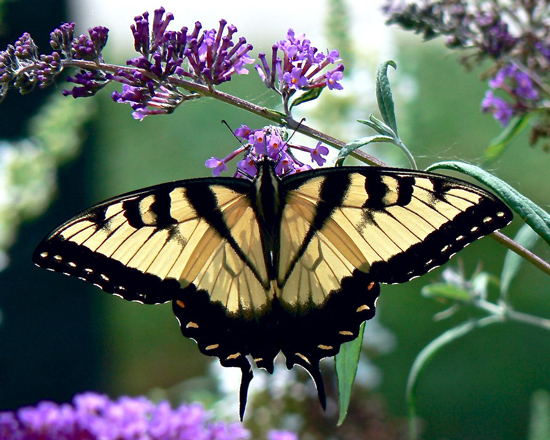by Jennie Cramer, Angela Loh, and Mary Squyres

Eastern Tiger Swallowtail with Butterfly Bush flowers
Creating a butterfly garden is a wonderful way for your gardening obsession benefit the world at large. Pollinators are a key component of global biodiversity, providing vital ecosystem services to garden and wild plants. There is clear evidence of recent declines in both wild and domesticated pollinators. While butterflies aren’t quite as efficient at pollination as bees, they are a critical piece of the pollination puzzle that keeps our native ecosystems and many of our food crops productive.
In order for butterflies to effectively pollinate they have a few requirements that cannot be ignored. They prefer flowers that provide broad surfaces for landing and have a narrow, spurred tube shape. Flowers with bright colors but faint scents are generally most attractive to butterflies. They also prefer flowers with features that help them find their way to the food source called nectar guides. Perennial flowers in several plant families fit this description, including the mint, milkweed, and sunflower families. Butterflies also pollinate members of other diverse plant groups including lupines, wild hollyhocks, violets, and even hostas.
Our butterfly friends require certain special amenities, including sunshine and shelter from the wind, water and minerals, and food choices for both caterpillar and butterfly stages throughout the growing season. With the right plant choices and landscape features, our yards and gardens can support many of the 163 species of butterflies found in New York State.
As butterflies go through their life cycle from egg to caterpillar to adult, they obtain food from two types of plants: nectar plants for the adults and host plants for the caterpillars There are countless species of plants that provide much-needed nectar for butterflies. Native plants support three times as many species of butterflies as nonnative plants. The following plant species produce nectar and are particularly attractive to butterflies in their flight stage:
– Joe-Pye weed*
– Lantana
– Goldenrod*
– Nasturtium
– Aster*
– Anise hyssop
– Coneflower*
– Cosmos
– Bee balm*
– Zinnia
– Liatris*
– Chives
– Black-eyed Susan*
– Yarrow
– Beauty bush (Kolkwitzia amabilis)
*Native plant
Host plants provide specific foods for caterpillars to grow and develop into adults. Some species of larva require a very specific host, while others may be less finicky and can munch on the leaves and stems of many plants. Different species of butterflies are adapted to different groups of closely related plants, their host plants. Some, such as monarchs, develop successfully only on milkweeds, while others have a wider array of host plants. For example, painted ladies have about 100 different species of host plants, from yarrow to sunflower and lamb’s quarters. Borage can be another fantastic host plant for a number of butterfly species. Following is a short list of other commonly found butterflies and their host plants:
– Fritillary: violet
– Mourning cloak: willow, birch
– Eastern black swallowtail: golden Alexander, parsley, other carrot family plants
– Eastern tiger swallowtail: aspen, tulip tree, pussy willow
– Spring/summer azure: dogwood, black cherry, sumac
– Viceroy: willow, pussy willow
– Pearl crescent: aster
– Sulphur: clover, other pea family plants, marigolds
For a list of butterflies in your county, their host plants, and their favorite nectar plants, go to butterfliesandmoths.org/checklists and search your location. You might notice that some of the host plants are native trees and shrubs. These plants are an important part of supporting caterpillars. For example, native oaks can support over 400 species of caterpillars! If planting a tree is beyond the scope of your current garden planning, be sure to keep in mind the importance of native trees when choosing a tree or shrub in the future.
In addition to food, a source of water, even a small puddle, is essential for butterflies. A mud puddle can provide water in addition to minerals they require. For a healthy environment for butterflies, use a minimum of pesticides. Learn to tolerate some damage.
It is also important to be aware of how and where the butterflies spend their winter. Many eggs or caterpillars are hidden among their host plants. A few species, such as mourning cloaks and tortoiseshells, actually hibernate as hardy adults in crevices, under leaf litter, or among evergreen vegetation. To increase the likelihood that your butterflies will survive the winter, reduce the amount of fall cleanup, postpone cutting down the host plants till late spring, and use the leaf litter as mulch in your garden beds.
It is a joyous wonder to make our gardens into homes for our beautiful winged friends. Once you’ve turned your yard and garden into a butterfly haven, you will have done a service not only to the butterflies and the plants they pollinate but also to native ecosystems and their inhabitants across the region.
Jennie Rebecca Cramer is horticulture program manager, Tompkins County Cornell Cooperative Extension, and Angela Loh and Mary Squyers are Master Gardeners.
Views: 0






